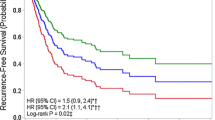Abstract
Objectives: We examined which occupations and industries are currently at high risk for bladder cancer in men. Methods: We combined data from 11 case–control studies conducted between 1976–1996 in six European countries. The study comprised 3346 incident cases and 6840 controls, aged 30–79 years. Lifetime occupational and smoking histories were examined using common coding. Results: Odds ratios for eight a priori defined high-risk occupations were low, and with the exception of metal workers and machinists (OR = 1.16, 95% CI = 1.02–1.32), were not statistically significant. Higher risks were observed for specific categories of painters, metal, textile and electrical workers, for miners, transport operators, excavating-machine operators, and also for non-industrial workers such as concierges and janitors. Industries entailing a high risk included salt mining, manufacture of carpets, paints, plastics and industrial chemicals. An increased risk was found for exposure to PAHs (OR for highest exposure tertile = 1.23, 95% CI = 1.07–1.4). The risk attributable to occupation ranged from 4.2 to 7.4%, with an estimated 4.3% for exposure to PAHs. Conclusions: Metal workers, machinists, transport equipment operators and miners are among the major occupations contributing to occupational bladder cancer in men in Western Europe. In this population one in 10 to one in 20 cancers of the bladder can be attributed to occupation.
Similar content being viewed by others
References
Vineis P,Simonato L (1991) Proportion of lung and bladder cancers in males resulting from occupation: a systematic approach. Arch Environ Health 46: 6-15.
Boffetta P,Jourenkova N,Gustavsson P (1997) Cancer risk from occupational and environmental exposure to polycyclic aromatic hydrocarbons. Cancer Causes Control 8: 444-472.
Silverman D,Morrison A,Devesa S. Bladder Cancer (1996) In: Schottenfeld D,Fraumeni J, eds. Cancer Epidemiology and Prevention. New York: Oxford University Press, pp. 1156-1179.
Kogevinas M,Trichopoulos D. Urinary bladder cancer (2002) In: Adami HO,Hunter D,Trichopoulos D, eds. Textbook of Cancer Epidemiology. New York: Oxford University Press, pp. 446-466.
Faggiano F,Partanen T,Kogevinas M,Boffetta P (1997) Socioeconomic differences in cancer incidence and mortality. In: Kogevinas M,Pearce N,Susser M,Boffetta P, eds. Social Inequalities in Cancer. Lyon: IARC Scientific Publications No. 138, pp. 65-176.
Claude JC,Frentzel-Beyme RR,Kunze E (1998) Occupation and risk of cancer of the lower urinary tract among men. A case-control study. Int J Cancer 41: 371-379.
Pohlabeln H,Jockel KH,Bolm-Audorff U (1999) Non-occupational risk factors for cancer of the lower urinary tract in Germany. Eur J Epidemiol 15: 411-419.
Pesch B,Haerting J,Ranft U,Klimpel A,Oelschlagel B,Schill W (2000) Occupational risk factors for urothelial carcinoma: agentspecific results from a case-control study in Germany. MURC Study Group. Int J Epidemiol 29: 238-247.
Cordier S,Clavel J,Limasset JC, et al. (1993) Occupational risks of bladder cancer in France: a multicentric case-control study. Int J Epidemiol 22: 403-411.
Hours M,Dananche B,Fevotte J, et al. (1994) Bladder cancer and occupational exposures. Scand J Work Environ health 20: 322-330.
Vineis P,Magnani C (1985) Occupation and bladder cancer in males: a case-control study. Int J Cancer 35: 599-606.
Porru S,Aulenti V,Donato F, et al. (1996) Bladder cancer and occupation: a case-control study in northern Italy. Occup Environ Med 53: 6-10.
González CA,López-Abente G,Errezola M, et al. (1989) Occupation and bladder cancer in Spain: a multi-centre case-control study. Int J Epidemiol 18: 569-577.
Serra C,Bonfill X,Sunyer J, et al. (2000) A case-control study on bladder cancer and the textile industry. Scand J Work Environ Health 26: 476-481.
Rebelakos A,Trichopoulos D,Tzonou A,Zavitsanos X,Velonakis E,Trichopoulou A (1985) Tobacco smoking, coffee drinking and occupation as a risk factors for bladder cancer in Greece. JNCI 75: 455-461.
Jensen MO,Wahrendorf J,Knudsen JB,Sorensen BL (1987) The Copenhagen case-referent study on bladder cancer. Risks among drivers, painters and certain other occupations. Scand J Work Environ Health 13: 129-134.
Cartwright R (1982) Occupational bladder cancer and cigarette smoking in West Yorkshire. Scand J Work Environ Health 8(Suppl. 1): 79-82.
Steineck G,Plato N,Gerhardsson M,Norell SE,Hogstedt C (1990) Increased risk of urothelial cancer in Stockholm during 1985-1987 after exposure to benzene and exhausts. Int J Cancer 45: 1012-1017.
Tola S,Tenho M,Korkala ML,Järvinen E (1980) Cancer of the urinary bladder in Finland. Association with occupation. Int Arch Occup Environ Health 46: 43-51.
International Labour Office (ILO)(1969) International Standard Classification of Occupations. Revised Edition 1968 Geneva.
StatisticalOffice of theUnited Nations(1968) International Standard Industrial Classification of all Economic Activities. Statistical papers series M, number 4, revision 2, United Nations, New York.
Kauppinen T,Toikkanen J,Pukkala E (1998) From crosstabulations to multipurpose exposure information systems: a new job-exposure matrix. Am J Ind Med 33: 409-417.
Bruzzi P,Green SB,Byar DP,Brinton LA,Schairer C (1985) Estimating the population attributable risk for multiple risk factors using case-control data. Am J Epidemiol 122: 904-914.
Greenland S,Drescher K (1993) Maximum likelihood estimation of the attributable fraction fromlogisticmodels. Biometrics 49: 865-872.
Vineis P,Di Prima S (1983) Cutting oils and bladder cancer. Scand J Work Environ Health 9: 449-450.
Silverman DT,Hoover RN,Albert S,Graff KM (1983) Occupation and cancer of the lower urinary tract in Detroit. J Natl Cancer Inst 70: 237-245.
Silverman DT,Levin LI,Hoover RN,Hartge P (1989) Occupational risks of bladder cancer in the United States: I. White men. J Natl Cancer Inst 81: 1472-1480.
Doll R,Peto R (1981) The Causes of Cancer: Quantitative Estimates of Avoidable Risks of Cancer in the United States Today. Oxford: Oxford University Press.
Cole P,Hoover R,Friedell GH (1972) Occupational and cancer of the lower urinary tract. Cancer 29: 1250-1260.
Morrison AS,Ahlbom A,Verhoek WG, et al. (1985) Occupation and bladder cancer in Boston, USA, Manchester, UK, and Nagoya, Japan. J Epidemiol Comm Health 39: 294-300.
Bouyer J,Hémon D (1993) Retrospective evaluation of occupational exposures in population based case-control studies. General overview with special attention to job exposure matrices. Int J Epidemiol 22(Suppl. 2): S57-S67.
Office of Population Censuses and Surveys(1980) Classification of occupations 1980, HMSO, London.
Author information
Authors and Affiliations
Corresponding author
Rights and permissions
About this article
Cite this article
Kogevinas, M., Mannetje, A.'., Cordier, S. et al. Occupation and bladder cancer among men in Western Europe. Cancer Causes Control 14, 907–914 (2003). https://doi.org/10.1023/B:CACO.0000007962.19066.9c
Issue Date:
DOI: https://doi.org/10.1023/B:CACO.0000007962.19066.9c



